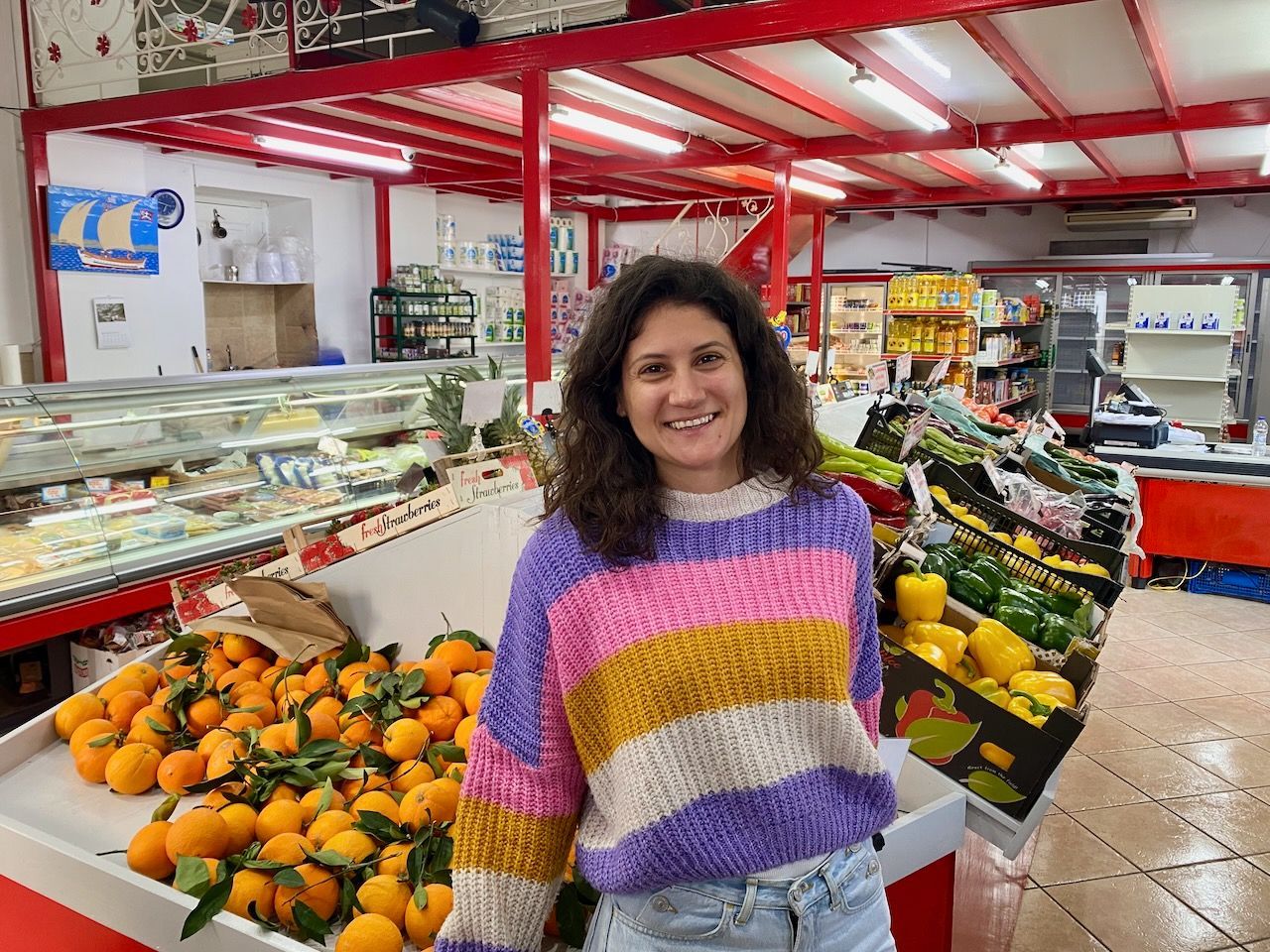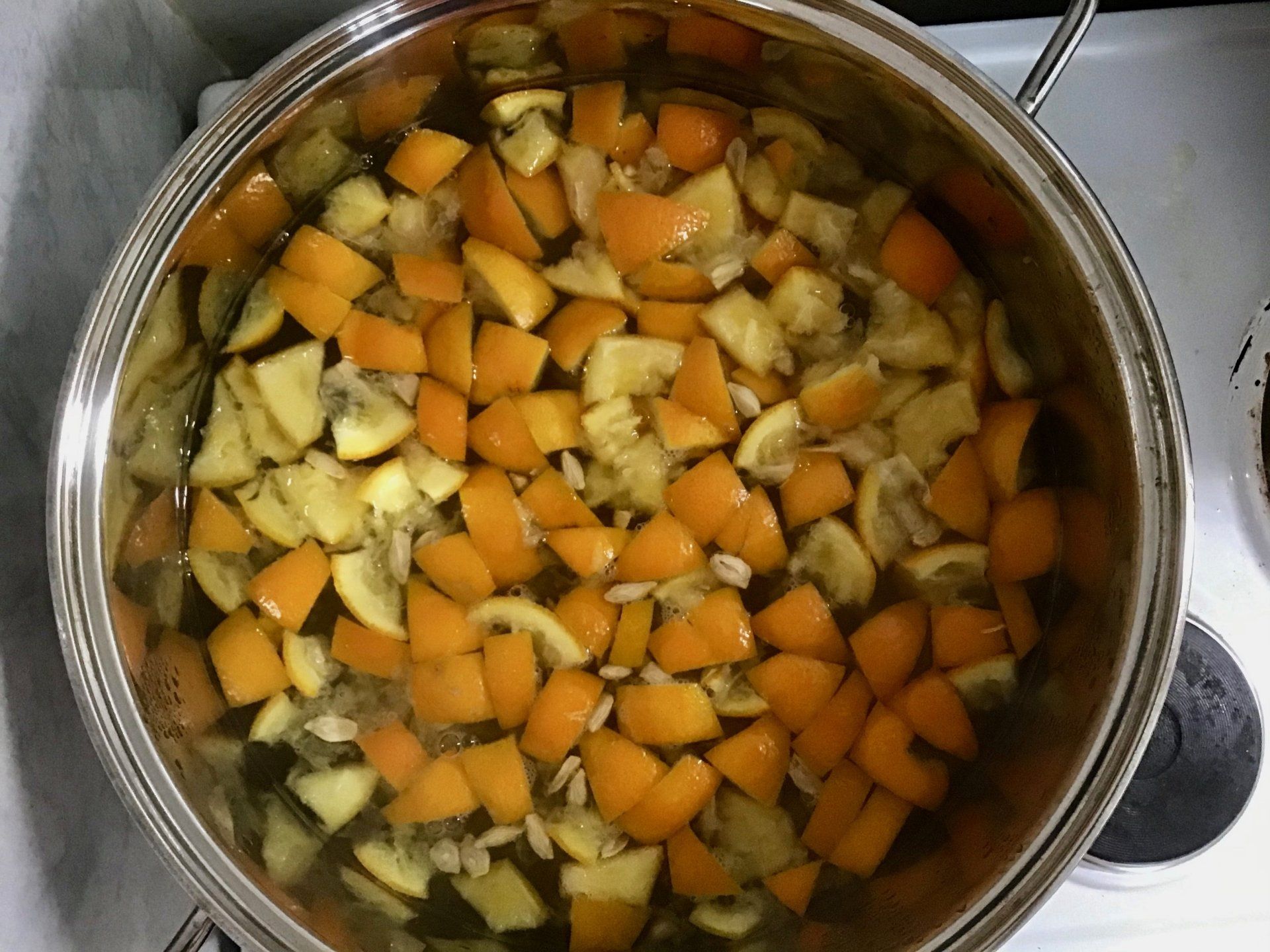Neranja Jelly From Hydra’s Street Trees
Recycled stockings have their uses

Hydra shops don't stock Seville oranges. So twenty years ago, I was delighted to discover that Hydra's street trees are burgeoning with a delicious and fragrant substitute, the Neranja orange. There aren't any shops that sell muslin squares either, so I recycle my laddered stockings when I make marmalade!
The garden squares in the town, the Artist's and Political gardens being two of them, are planted with many citrus fruit trees where locals are welcome to forage. Twenty years on, I still revel in the simple joy of being able to pick a lemon, fresh from the tree on my way home from shopping!
I wholeheartedly approve of this Greek tradition to plant streets and squares with fruit trees. It's good for the bees and a great source of vitamin C for the locals. And it's more productive and helpful than less fragrant ornamental shrubs.
These days, the Greek diet is so much richer with Vit-C sources readily available, so much of this freely available fruit drops to rot on the ground and pavement as few people bother to preserve it now. These days, the insects on Hydra tend to be the biggest beneficiaries of this seasonal largess.
But there are still enough Hydra people like me who enjoy 'homemade' rather than 'shop bought' whenever possible. So I am not the only person who gleefully watches the fruit ripen in anticipation of binge fruit stewing in December and January.
The Neranja orange has a robust flavour with a slight underlying perfume that's incredibly fragrant and makes a very distinctive marmalade. The peel even when cooked is quite chewy, which is why I opt to make shredless jelly. The juice is so bitter that even the enamel on your teeth curls if you try drinking it. But it's packed with pectin which gives a superb and very satisfying jelly set to the finished result.
I generally make three batches a year. The first 12 jars go to friends and family as New Year presents and the third batch keeps me going for the year. Because the jelly is shredless, the preparation time is minimal, and as we're still in CoVid lockdown, I have enough time on my hands to make more. Fortunately, Vaso and Antonis at the Hydra Home shop stock glass jars with lids because I don't have enough to recycle. (Large hint to family and friends to return gift jars if they'd like them refilled!)
The final result is about six good-sized jars of deliciously fresh, bitter orange marmalade that isn't too sweet. Perfect for breakfast or an evening snack with a strong cup of tea.
So for my Hydra friends who don't have a method of their own to annually perfume their homes, here's my recipe that I am happy to share.
Don't be tempted to make too much at a time. There's nothing worse than sticky juice boiling over the top of the pan to clean up!
Equipment
You will need a pan that is at least 4-litre with a very thick base and a close-fitting lid.
A second large saucepan
2 small plates (in the freezer to get cold)
Large fine-mesh sieve
Large muslin 40cm square and a piece of string or my preferred choice - an old, (washed) stocking.
1 large dinner plate
Long-handled metal spoon
6-8 glass jars with lids (300 - 450grm capacity)
Ingredients
900g Neranja Oranges
1 large lemon
2.25ltr water
1.8kg sugar (nothing special, just ordinary granulated sugar will do)
Time: 4.5 hours, including 2 hours for fruit simmering.
When you collect the fruit, don't use the ones on the ground. The tough skin doesn't show any bruising from the fall, so you could end up lugging a kilo of fruit home only to find it rotten inside. Ideally, you want to pick the fruit straight off the tree. If it takes more than two twists to come off the branch, it's not ripe enough!
Method
- Wash and dry the fruit to get rid of dust, etc.
- Cut in half and squeeze the juice out.
- Cut the peel into small pieces (about 1.5cm square)
- In your largest pan, combine the water, juice, skin, pith and pips.
- On a high-heat and the lid on, bring it all to boil.
- Just before it reaches rapid boiling point, turn the heat down to a simmer so that the fruit pieces are just about still moving gently.
- Simmer for 2 hours with the lid on so the water doesn't evaporate too much.
- When you can easily squash a piece of skin between your fingers (use a long-handled metal spoon and blow to cool the piece before you handle), it will be ready for the next stage.
- Put the second large saucepan in the sink with the sieve resting in it.
- Gently pour the liquid and fruit pieces into the sieve.
- Hold the sieve up and gently rock it back and forth until it stops dripping. Don't be tempted to press the fruit, skin, pith and pips in the sieve as this will make your final jelly cloudy. (It will taste just as good but won't be so gem-like at the end).
- Put the strained fruit contents from the sieve in the centre of the muslin square, then pull the edges up and securely tie making a ball. OR, (tip handed down from my Mum) spoon the contents of the sieve into the toe of a stocking and knot it. Place the muslin or stocking on a large plate to cool.
- Wash your original large pan, making sure there are no bits stuck to the bottom, rinse it well and dry.
- Return the strained, clear juice to the cleaned large pan.
- With the lowest heat, start adding the sugar a little at a time to the juice. Gently stir so the granules don't stick to the side with a long-handled metal each time until the sugar has completely dissolved.
- Pre-heat the oven to 180c (to sterilise the jars)
- When it's cool enough to handle, squeeze the muslin or stocking ball to extract the pectin. Squeezing is a messy and sticky job best done near the sink. As you squeeze the ball, lots of thin juice will come out first. Keep it on the dinner plate. Then a thick, yellow substance will ooze through the fabric between your fingers. This is the pectin that will make your jelly set. Scrape the pectin off the fabric with your fingers and let it collect it in a pile on your plate. You will need about 2 dessert spoons of pectin (the thick stuff). (Once you've extracted the pectin, the remaining 'mush' can be thrown away.)
- Add the extra juice and pectin to the syrup pan.
- Make sure that the sugar and pectin have dissolved completely. Even if a few sugar granules remain, it will burn and stick to the pan's bottom, which could ruin everything. It usually takes me 1 hour of occasionally stirring on the lowest heat from adding the sugar to it being entirely ready for boiling - don't rush this stage as it's the most vital. At this point, you have a syrup.
- A 4 ltr pan is too small to reach the correct boiling point, so you will need to pour half the syrup into your other (clean) pan and put it to one side.
- Put your jars (lids off) upside down in the oven to sterilise them so the final jelly won't become tainted even in a year.
Start timing when it just starts to boil like this
SAFETY FIRST
From this point, you must give your undivided attention. So send the kids away, ignore the phone and make sure you have immediate access to cold water in case you splash yourself with boiling syrup. And you will need to watch the syrup and clock very closely to avoid burning or boiling over, so you don't want any distractions.
- Turn up the heat under the pan with the first half of your syrup and bring to a rapid boiling point. (You will need your extractor on or the window open because there will be a lot of steam.)
- As soon as the surface starts bubbling quickly, start timing.
- As the syrup gets hotter, it will bubble up closer to the top of the pan, right to the edge. If you think it will boil over, blow gently on the top. Don't stir or disturb it with a spoon. The syrup must boil as hot as possible for at least 8 minutes.
- After boiling for 8 minutes, (keeping it on the heat) quickly take a plate from the freezer and using the long-handled metal spoon dip into the boiling syrup.
- Drip about a teaspoon worth onto the plate. Carefully nudge the jelly on the plate with your fingertip. If it crinkles, then it is done. (Try to do the tests within 15 seconds.)
It will bubble up this much in 9 minutes if you are doing it correctly!
- Most likely, it will still be runny, so continue boiling for another 2 minutes. Repeat the test. It should form a skin that crinkles by now. Also, the syrup will be alarmingly bubbling right at the top of the pan by now. (This is normal and desired - hence needing a bigger pan or boiling in two lots.)
- As soon as you have a hint of a skin that crinkles, take the pan off the heat and let it cool until the surface is still (about 15 seconds).
- Remove 4 jars from the oven. Turn the oven heat off but leave the remaining jars inside.
- Carefully and very slowly pour or ladle a small amount of the syrup into the first jar. It will bubble frantically (it's normal) and when the bubbles subside, continue to pour slowly right up to the neck of the jar. Repeat for all jars (you might find that one jar isn't filled to the top, don't worry it will be from the next batch.)
- Use a teaspoon to lift the foamy skin off the top and then put the cold lid on each hot jar. (Gloves or dry cloth imperative.)
- Don't tighten the lid too firmly as it will get tighter when the jar cools and you will want to open it later. As the jars cool, you will hear the lids pop, and they will depress to give a perfect long-lasting seal.
- I have ruined the 2nd half of a batch before by not cleaning the boiling pan, so you must wash and dry it before boiling the 2nd half.
- Pour the 2nd half into the boiling pan, turn up the heat as high as it will go. As soon as it starts to boil, start timing. At 8 minutes, do your crinkle test. Boil for another 2 minutes if necessary. 'Jar up' as before. If you have a half-filled jar from the first half, remember to remove the foamy skin first before you top it up to avoid a white line in the middle.
- Leave the jars to completely cool before you put a label on otherwise it won't stick.
If the jars were sterilised correctly, filled to the top and with a good seal, I have found the marmalade can stay perfect for 12 months. Although it has to be said, it is rare to resist a single batch for that long!
Warm regards to everyone and a Happy New Year for what I hope will be an easier 2021 for all.
Share this post





















